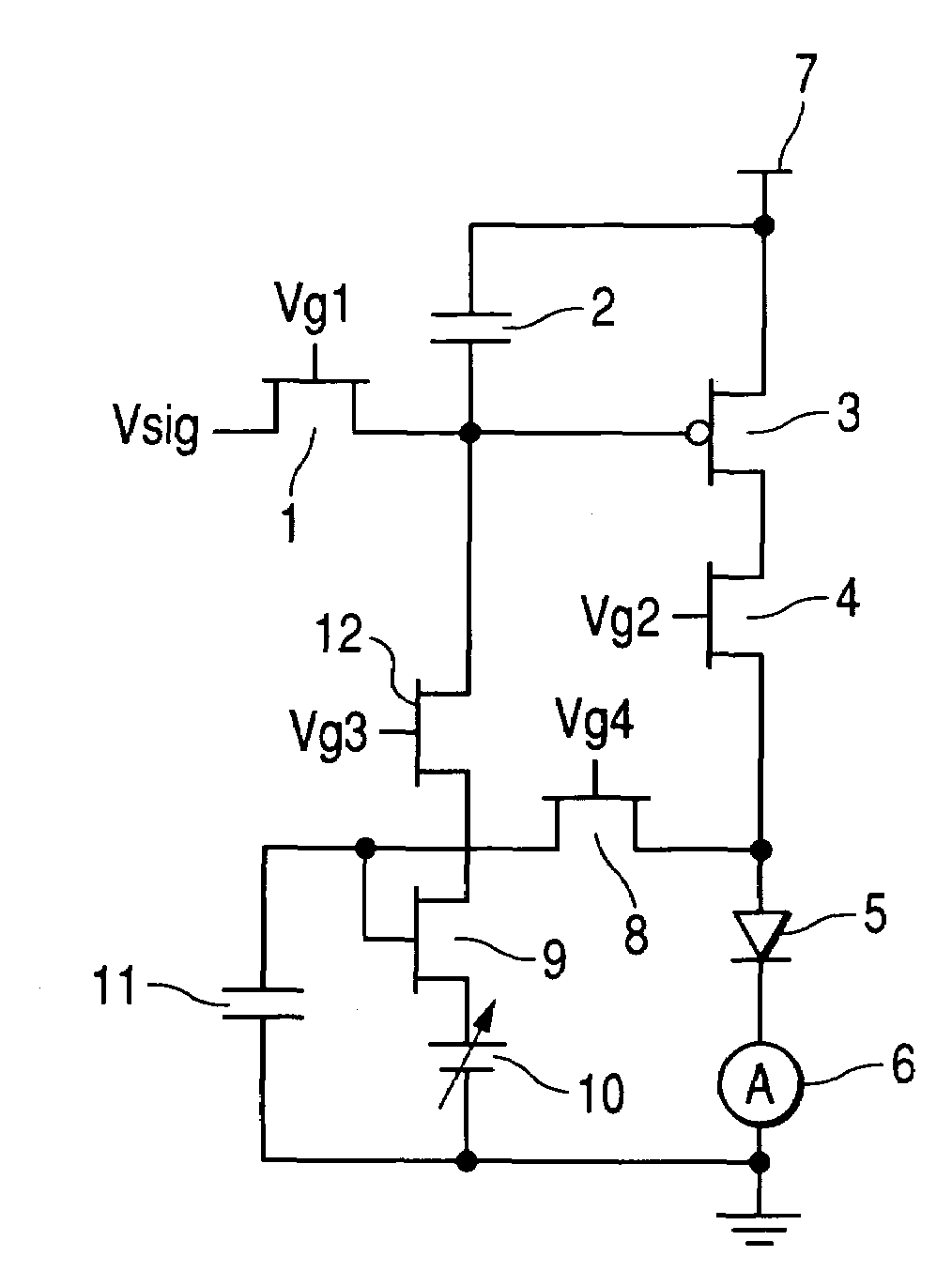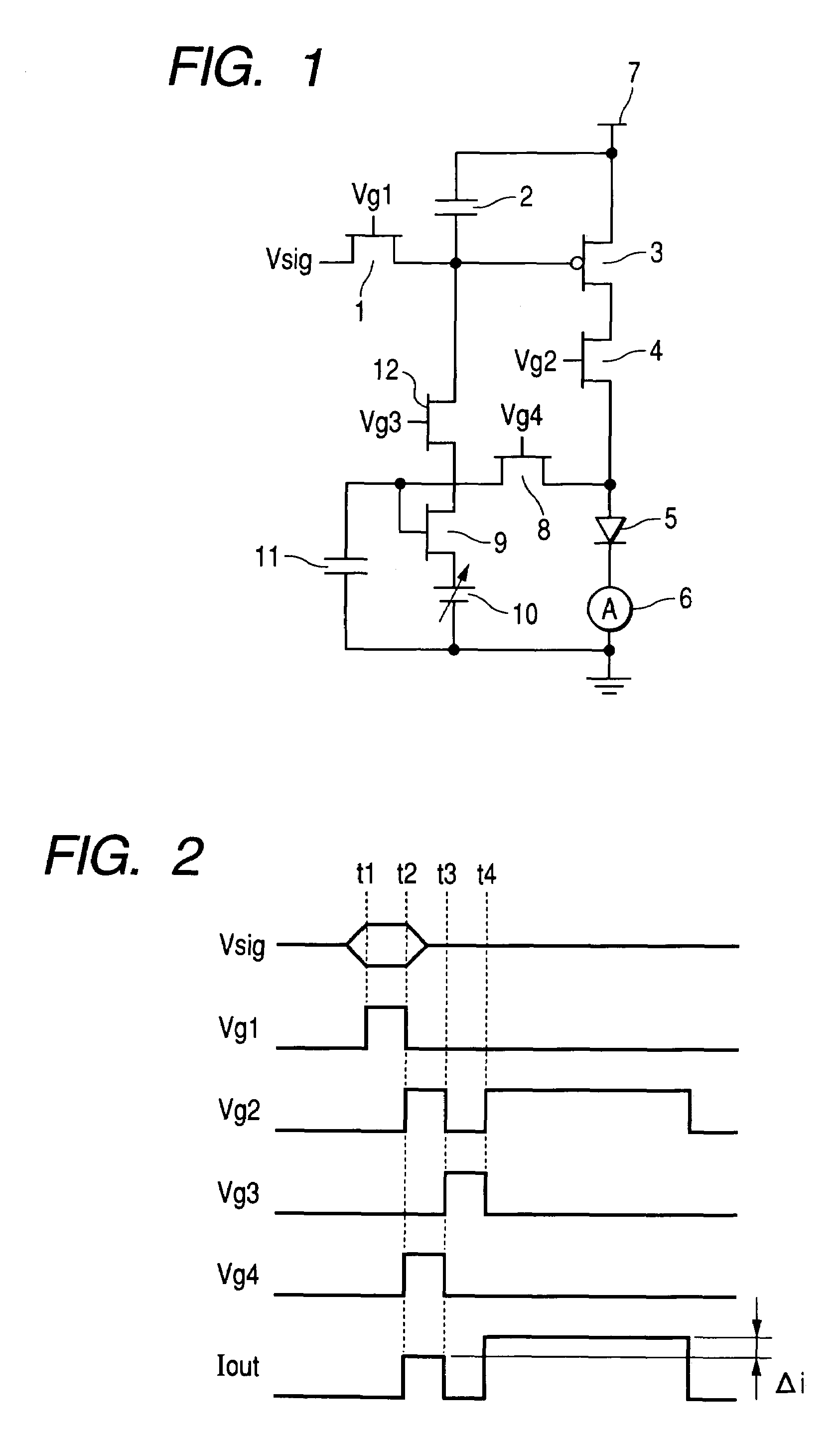Drive circuit and image forming apparatus using the same
a technology of drive circuit and image forming apparatus, which is applied in the direction of electric digital data processing, instruments, computing, etc., can solve the problem of difficulty in compensating for a change in luminance by a unit of frame for each pixel
- Summary
- Abstract
- Description
- Claims
- Application Information
AI Technical Summary
Benefits of technology
Problems solved by technology
Method used
Image
Examples
first embodiment
[0048]FIG. 1 shows a pixel circuit of an embodiment of a display element of the invention. As a load, a light-emitting element 5 is used. In the figure, reference numerals 1, 3, 4, 8, 9 and 12 denote TFTs. Only the TFT 3 is a p type and the other TFTs are an n type. Reference numerals 2 and 11 denote capacitors; reference numeral 6, an ammeter; reference numeral 7, a power supply; and reference numeral 10, a variable or fixed bias voltage supply. In the figure, the TFT 3 is a drive transistor and the TFT 9 is a second transistor. The ammeter 6 is unnecessary in an actual drive circuit.
[0049]A drive circuit for the load of this embodiment is a voltage programming type. An input signal according to a voltage corresponding to a display luminance is applied to each pixel circuit as a display signal Vsig. An operation of the pixel will be explained according to a timing chart of FIG. 2.
[0050]The display signal Vsig corresponding to a luminance of a display in the next frame is inputted t...
second embodiment
[0055]FIG. 3 shows a pixel circuit of a second embodiment of the display element of the invention. In the figure, reference numeral 12 denotes a nonlinear element having a diode characteristic and 14 denotes a p-type TFT. As a load, the light-emitting element 5 is used.
[0056]In the pixel circuit of this embodiment, the variable bias voltage 10 of the pixel circuit of the first embodiment is changed to a nonlinear element 13 and a current mirror circuit is constituted by the TFT 3 and TFT 14 serving as the drive transistors. An operation of this pixel circuit will be explained according to a timing chart of FIG. 2.
[0057]When a display signal is decided at time t1, Vg1 rises to H and the TFT 1 is turned ON, a charge corresponding to a display signal is accumulated in the capacitor 2, and gate potentials of the TFTs 3 and 14 are set. Subsequently, at the time t2, Vg1 falls to L and, at the same time, Vg2 and Vg4 rise to H, and the TFT 1 is turned OFF and the TFTs 4 and 8 are simultaneo...
third embodiment
[0060]FIG. 4 shows a pixel circuit of a third embodiment of the display element of the invention. In the figure, reference numerals 3, 14, 15 and 16 denote p-type TFTs and reference numerals 1, 8, 9, 12 and 17 denote n-type TFTs. As a load, the light-emitting element 5 is used.
[0061]The display element is a current programming type, and a display signal Idata, according to a current corresponding to a display luminance, is applied to each pixel circuit as an input signal. An operation of the pixel will be explained with reference to a timing chart shown in FIG. 5.
[0062]A display signal corresponding to a luminance of display in the next frame is inputted to an input terminal of the n-channel TFT 1, serving as a transistor for address, and, at decided time t1, gate potentials Vg1 and Vg6 of the TFTs 1 and 17 rise to H. At the same time, a gate potential Vg5 of the TFT 16 falls to L, the TFTs 1, 17 and 16 are turned ON and a charge corresponding to a voltage value of the display signa...
PUM
 Login to View More
Login to View More Abstract
Description
Claims
Application Information
 Login to View More
Login to View More - R&D
- Intellectual Property
- Life Sciences
- Materials
- Tech Scout
- Unparalleled Data Quality
- Higher Quality Content
- 60% Fewer Hallucinations
Browse by: Latest US Patents, China's latest patents, Technical Efficacy Thesaurus, Application Domain, Technology Topic, Popular Technical Reports.
© 2025 PatSnap. All rights reserved.Legal|Privacy policy|Modern Slavery Act Transparency Statement|Sitemap|About US| Contact US: help@patsnap.com



